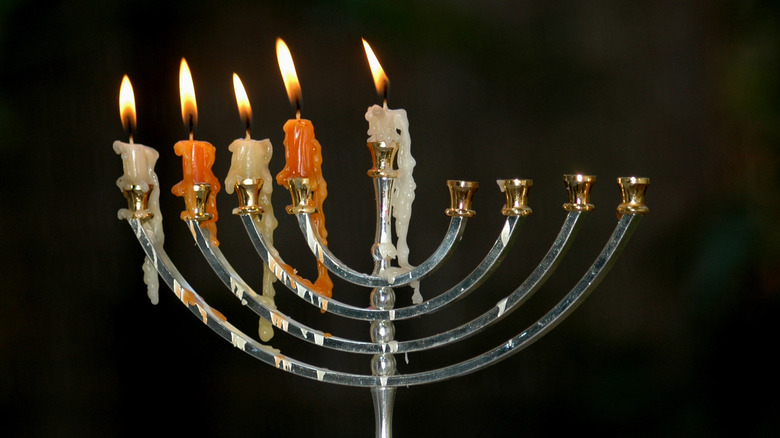Cleaning Your Menorah Is Easy With These Helpful Tips
We may receive a commission on purchases made from links.
Whether Hanukkah is approaching or has just passed, it's important to keep your menorah cleaned of the eventual wax (and everything else) that accumulates over the eight-day Jewish festival of lights. The religious celebration calls for the lighting of candles over the course of the holiday, and that kind of wax buildup can be tough to tackle. Luckily, we have a few helpful tips to cleaning your menorah, no matter what it's made of, and getting it looking like new again. From removing the candle wax to polishing it back into shape with a homemade solution, House Digest has you covered.
Menorahs come in all shapes and sizes, and many different materials as well, and the candles used to melt in them have infinite variations as well. Just as there are different methods for cleaning a wooden menorah than a silver one, there are also preventative measures to take by virtue of the candles you choose to burn. As the adage goes, "an ounce of prevention is worth a pound of cure," which in this case means you should consider dripless candles as a way to prevent unnecessary messes in the first place, or prep your menorah with cooking spray first. However, since candles made from paraffin wax create more harmful air pollutants than soy or beeswax candles do, you may want to use these types of menorah candles as well. Also, it's important to note that since all candles made today emit steady flames, they are all considered kosher, regardless of ingredients.
Removing the wax from your menorah
Since candle wax is most malleable when melted, the easiest way to remove it is to warm it up again. You can use a hair dryer, hot water, or even possibly put it in the oven, but you need to be very careful. If your menorah is made of metal, it can withstand a lot of heat but will also conduct it, so wear oven mitts. Place the brass, silver, or other metal-based menorah upside down on a piece of parchment paper on a baking sheet or run it under hot water. For mild to moderate buildup, steady sweeps over the menorah with a hairdryer for a few minutes should see the wax start dripping out and onto the parchment paper. If there's a large amount, though, it might be better to break off what you can and then put it in the oven on a very low temperature (around 200 degrees Fahrenheit). This should speed up the melting process for larger wax problems.
Another option is to freeze the menorah and crack the wax off that way — in large blocks without crumbling — but certain delicate materials like glass, porcelain, and wood can be damaged by extreme temperature changes. If your menorah is made from one of these, use milder methods (lower hairdryer setting, for example) to soften the wax. For cleaning wax off wood and glass menorahs, a mixture of vinegar and water may help to wipe it away with a damp cloth as well.
Washing and polishing your menorah
More than likely, whatever material your menorah is made out of, light dish soap and water should be all you need to keep it clean. Simply wipe it down gently, then rinse with a clean, damp cloth and pat dry. There are specialty cleansers available, but unless you're positive your menorah is brass and not brass-plated, for example, these could cause more harm than good. A mild detergent is a safer way to go if you're unsure.
To polish your menorah, it entirely depends on the material. Wooden pieces should be rubbed with a mixture of olive oil and lemon juice to help bring out the wood's natural beauty while sealing it from moisture. Brass- and silver-plated menorahs, meanwhile, can simply be dry buffed to avoid damaging the thin outer layer of plating.
However, true brass and silver require polishing. If you don't have the correct commercial polish, try these tips. For silver, line a bowl with aluminum foil and pour boiling water into it. Add 1 tablespoon baking soda for every cup of water, then place your menorah in the mixture so it touches the foil. Let it sit in the solution for up to 10 minutes, then buff with a microfiber cloth. For brass, put the menorah in a bowl with white vinegar and warm water (1:2 ratio) for four hours, then buff dry. Be careful not to remove too much "patina" — the antique-looking tarnish that develops over time — because it adds value to a piece.


